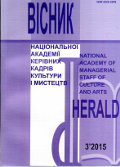PROBLEMS OF A DIFFERENT NATIONALITY STAGE EMBODIMENT WORKS IN THE UKRAINIAN DRAMA THEATER (60-80 YEARS OF THE 20 CENTURY)
DOI:
https://doi.org/10.32461/2226-3209.3.2015.138451Keywords:
Ukrainian theater, dramaturgy of other nationalities, national art, staging of national characterAbstract
The article deals with the problem of a different nationality scenic embodiment of products in the Ukrainian drama theater. In 1960 the governing bodies of the country, leading the line for the merger of nations intensified holding various celebrations, festivals and parades, among which the emphasis was referred to as magnificently looking brotherly drama. Each theater of Ukraine had to show a play by playwright any union republic. But there is a silver lining.
The Ukrainian national drama was in extremely adverse conditions. But the possibility of recourse to the play created in other republics where censorship oppression were immeasurably weaker allowed Ukrainian theaters to cling to the power of the arts and to highlight the important issues of social life, have a great influence on the formation social consciousness of the Ukrainian people. When they stimulated the distinctive development of the Ukrainian national theater.
However, when referring to the works of masters of the stage drama of a different nationality there are significant ideological and artistic problems to be a practical solution. They are studied in the article These problems can be divided into two broad categories. The first is general aesthetic character and brings together such important issues as the treatment of stage master the concepts of national and international, the interpretation of the spirit of international exchange. It can be considered that a lot of scientists on this problem: aestheticians and art historians who have come to certain conclusions.
The second group covers the issues that are specific to the theatres. There are a lot of outstanding issues still. Special attention is given to them.
The author emphasizes that a proper understanding of the concept of national scene masters in the art did not come immediately. Many figures of theatre and in the 40s, 50s, 60s and even the 70s of the twentieth century, expressed doubts about the need to put on the stage any works of dramatic art of other nations. They argued that, as you know, any work in translation to some extent makes the original text poorer and it can lose its cultural value. The article gives examples of such statements of the leaders of various national theaters – Russian, Georgian, German and others.
The author also pays attention to such a very complicated particular issue as the staging of non-indigenous character which is not able to everything, even an outstanding actor. For example, E. Rossi, who played Ivan the Terrible in the play of Tolstoy. However, this example as it may sound paradoxical, because it demonstrates the feasibility of staging the works of a different nationality drama. For a master of the scene still managed to find in the work of others for themselves relevant people thought that interested viewers around the world, where he is on tour. Immediately examples – like the dignity of the playwright actor stressed that nationality genius William Shakespeare with the greatest force was able to convey the Italian T. Salvini.
Today, the need for staging plays by writers of different nationalities, have no one in doubt. However, there unsolved problems specific theater there are many more. There were they, we think, because formulate distinctive national features in this art as theater, it is practically impossible. This idea was expressed by many critics in the 70 years of the twentieth century that has elapsed since the time failed to refute. The article gives examples of how Ukrainian theaters to solve these problems. Gradually, the rule for them grew deeper and respect for the works of a different nationality drama.
However, here there is still one of the very important issues – how to understand this respect, and what exactly it should manifest itself?
The article presents the different interpretations of this issue in drama, who saw it in a careful study of the features of the people, whose life is shown on the stage, his national identity. Agreeing with this definition, the author at the same time indicates that it does not quite cover all aspects of the problem and sets out his point of view.
Based on the fact that the main task of the artist – a reflection of the life of his people by means of art, the author concludes that the scenic embodiment works of a different nationality drama has the same rights and the pursuit of accurate transmission of the national character, and away from national peculiarities in his gear, and even the creation of its national scenic nature based on the nature of the dramatic works of other nationalities.
According to the author, all three variants of solving the problem – legitimate and contribute to the development of national art.
Downloads
Published
Issue
Section
License
Authors who publish with this journal agree to the following terms:
1. Authors retain copyright and grant the journal right of first publication with the work simultaneously licensed under a Creative Commons Attribution License that allows others to share the work with an acknowledgement of the work's authorship and initial publication in this journal.
2. Authors are able to enter into separate, additional contractual arrangements for the non-exclusive distribution of the journal's published version of the work (e.g., post it to an institutional repository or publish it in a book), with an acknowledgement of its initial publication in this journal.
3. Authors are permitted and encouraged to post their work online (e.g., in institutional repositories or on their website) prior to and during the submission process, as it can lead to productive exchanges, as well as earlier and greater citation of published work (See The Effect of Open Access).


